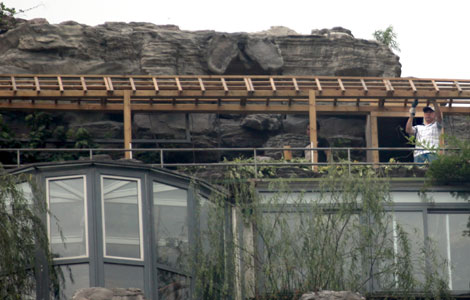Dream of a banquet
Updated: 2013-08-17 00:06
By Ye Jun (China Daily)
|
||||||||
In Yangzhou, diners get a taste of the cuisines described in the literary classic
A Dream of Red Mansions, complete with the right ambience. Ye Jun reports.
A 300-year-old food style in a very prosperous part of China is revived for present day gourmets in the Huaiyang culinary capital of Yangzhou. Cuisine masters of the city have recreated food recorded in A Dream of Red Mansions, one of the four most important ancient Chinese novels.
Called the Red Mansions banquet, the special dishes are served in Yangzhou State Guesthouse.
 |
|
Red-robed shrimps is said to be a favorite dish of Jia Baoyu, the decadent protagonist of A Dream of Red Mansions. [Photos by Ye Jun / China Daily] |
Not only does the meal bring back memories of a lifestyle that is three centuries old, the entire ambience of the guesthouse projects nostalgia. One musician plays guqin, a very soothing ancient stringed instrument, while waitresses clad in ancient Chinese gowns serve beautiful, delicate plates of dishes in a colorfully decorated room.
Guests get to try tasty and thoughtfully named dishes, such as "red-robed shrimp", "eight treasure" bean sauce, and "emerald" shaomai.
A waitress will tell you the red robed shrimp is a favorite of Jia Baoyu, the male protagonist in the novel, and the purple ginger sprout is the favorite of Lin Daiyu, the female protagonist.
Several of the dishes are named after roles in the classic novel. Qingwen bun has a special stuffing of bean curd. It is named after Qingwen, Jia Baoyu's servant girl and close friend with a strong personality. A crisp cake with turnip stuffing is named after Taijun, Jia Baoyu's grandmother, because it has black sesame on top, resembling the hairstyle of old women in ancient China.
One delightful thing about Huaiyang cuisine is, the dishes may look simple but they're tasty because of the complicated cooking methods. For example, dazhu gansi, water-boiled bean curd slices, and yangchunmian, or "plain noodle", with shrimp sauce, and pieces of green onion.
Located in the center of Jiangsu province, Yangzhou is a stronghold of Huaiyang cuisine, one of four major cooking styles of the country.
With the Beijing-Hangzhou Grand Canal flowing past it, the area around Yangzhou saw the biggest flow of the country's salt business. In what was considered China's most flourishing ages, under the reign of emperors Kangxi (1654-1722) and Qianlong (1711-99), Yangzhou rendered one third of the country's annual revenue.
That's the reason why the two emperors often visited the area by boat, adding to the city's fame and prosperity. Visiting officials and business people contributed to the buoyancy of the local restaurant industry. Rich salt traders built their houses adorned beautiful gardens, and have their own chefs.
Scholars believe the lives of big families written in A Dream of Red Mansions is based on the author Cao Xueqin's own life in Yangzhou.
"The family of Cao Yan, the grandfather of Cao Xueqin (1724-64), lived here for several generations," says Chen Wanqing, deputy general manager of Yangzhou State Guesthouse. "Cao Yan was an important official in charge of salt transportation of the area. Therefore we think Cao Xue-qin's novel is based on his early life in Yangzhou."
Chen says Yangzhou chefs started to collect materials for a Red Mansions cuisine since late 1970s. A set of cuisine was formed in the late 1980s. Since the beginning of 1990s, the cuisine spread to many parts of China, receiving very warm response.
Yangzhou State Guesthouse has presented the food at more than 20 countries and regions over the years.
There are four parts in the banquet: decoration dishes, cold dishes, main dishes and dim sum. Daguan Yipin, or first class dishes of Daguan Garden, where Jia Baoyu lives, is a set of dishes showcasing delicate and elaborate cooking skills, mostly for appreciation.
One example is "pine tree and crane for longevity", a dish that looks like a painting made with egg, mushroom and cucumber slices. "Peacock flaunting its tail" is made entirely with prepared flour.
Red Mansions banquet has a set of simple but delicious cold dishes, such as eggplant with nuts, and duck tongue flavored with yellow rice wine.
Qiexiang, diced eggplant with nuts, is a dish Wang Xifeng, a domineering woman role in the novel, shows off to Liu Laolao, a distant relative from the countryside. It is a typical dish reflecting how elaborate a simple dish can be, using ordinary ingredients but complicated cooking methods. An eggplant is peeled, diced and deep-fried with chicken oil. Then it is fried together with diced mushroom, bamboo shoots, bean curd and an array of nuts such as pine nuts, which are first soaked in chicken broth for its flavor, and then dried.
The grand banquet itself features big dishes that used to only appear on important occasions, or only to treat important guests. Some of these are clear-steamed Reeves shad, and "lion head" pork meatball in clear soup.
The fourth part of the banquet has various dim sums recorded in A Dream of Read Mansions.
The banquet is now available at the guesthouse for breakfast, lunch and dinner. Because the preparation is complicated, the hotel and its restaurant offer it only to groups with more than five people. Patrons can order a set meal, or a la carte dishes.
Zhou Xiaoyan, Huaiyang cuisine master, says Yangzhou cuisine has deep cultural meaning.
"First of all, it is very particular about the right ingredients," he says. "A lot of attention is placed on using seasonal produce. Ingredients don't need to be expensive, but must have high quality."
Zhou says to recover the cuisine style recorded in the book, chefs need to both follow the book, and cater to modern people's consuming habits, which stress nutrition and health.
Contact the writer at yejun@chinadaily.com.cn.

 Thrills in store for Chicago Air and Water Show
Thrills in store for Chicago Air and Water Show
 Demolition work starts on rooftop villa structure
Demolition work starts on rooftop villa structure
 Memorial to expeditionary soldiers opens
Memorial to expeditionary soldiers opens
 Death toll from Egypt violence rises to 638
Death toll from Egypt violence rises to 638
 Tunes that travel
Tunes that travel
 Macabre Addams Family tests musical tastes
Macabre Addams Family tests musical tastes
 Spielberg has desire to work with Zhang Yimou
Spielberg has desire to work with Zhang Yimou
 Li Na advances to 3rd round at Cincinnati Open
Li Na advances to 3rd round at Cincinnati Open
Most Viewed
Editor's Picks

|

|

|

|

|

|
Today's Top News
US urged to share with China
Exporters take heart from signs of US rebound
Clinton: US behind China in Africa
Chinese reduce Treasury holdings
Canadian deal boosts Chinese aircraft ambitions
The 'bad boys from Boston' are set to rock Shanghai
Global universities ranked by survey
No remorse as Abe marks surrender anniversary
US Weekly

|

|







